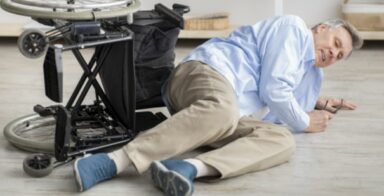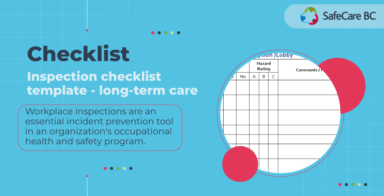When should you do inspections?
- Scheduled at all workplaces, with enough frequency to prevent unsafe working conditions, for example
- daily, weekly, or monthly of equipment (such as overhead or floor lifts)
- pre-use and post-use of a vehicle
- daily or weekly by supervisors
- weekly or monthly of departments (such as laundry/housekeeping, kitchen/food services, recreation services, maintenance, occupational therapy/physiotherapy department, beauty salon, and administrative offices)
- Inspections as required by an incident or malfunction (for example, after a laundry dryer fire) or when you add a new process or equipment (such as new kitchen equipment)
Workplace Inspections
Workplace inspections include:
- structures, and external surrounding areas (for example, buildings and the property outside)
- equipment, tools, machinery (for example, lifts, carts for medication or laundry, furniture)
- work methods and practices (for example, handling of residents and hand hygiene)
Who does the inspections?
Where feasible, inspections must include the participation of the joint occupational health and safety committee or worker health and safety representative. Inspectors should be familiar with the work process and the areas they inspect. Inspectors must be given instructions in the inspection system and be aware of the standards in the areas they inspect.
What should you do before an inspection?
Develop written organizational policies, procedures, and tools, including a checklist and floor plan guide to ensure consistent and effective inspections.
Before each inspection, inspectors should:
- Review the previous inspection and incident records to help look for issues.
- Define the areas or items to inspect and review the planned path.
- Have a toolkit including a floorplan guide and a checklist, means to record findings (a portable electronic device or a pen/paper, camera), suitable clothing and relevant personal protective equipment.
- Contact the supervisor in charge of the area(s) to be inspected.
What should you do during an inspection?
- Look out for other hazardous conditions besides what’s on the checklist. Look up, down, inside, and around.
- Ask questions to workers being mindful to avoid interrupting their activity.
- Inform the supervisor about any immediate danger before leaving the area (if the supervisor is not on the inspection team).
- Record items even if they are corrected during the inspection.
- Never ignore any items because you feel you don’t have adequate knowledge to judge safety.
What happens after an inspection?
Inspectors must report unsafe or harmful conditions to a supervisor or the employer without delay (although inspectors might respond to a situation during the inspection, such as putting up a wet floor sign where there’s a spill or removing a broken step stool). The supervisor or employer receiving a report must investigate and take corrective action. Avoid using findings from inspections for disciplinary measures.
The joint occupational health and safety committee should also receive a copy of the report to review.
Review the general inspection requirements in the Occupational Health and Safety Regulations sections 3.5 to 3.11 for more information.










